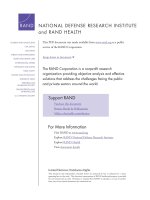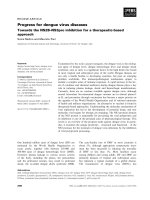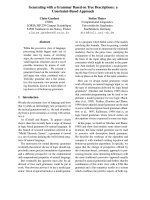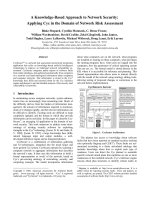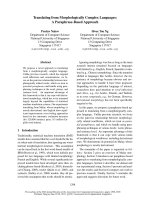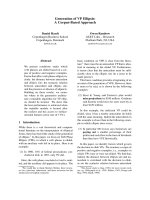statistical analysis methods for chemists a software based approach
Bạn đang xem bản rút gọn của tài liệu. Xem và tải ngay bản đầy đủ của tài liệu tại đây (23.9 MB, 392 trang )
Statistical Analysis Methods for Chemists
A Software-based Approach
Statistical Analysis
Methods for Chemists
A Software-based Approach
William P. Gardiner
Department of Mathematics, Glasgow Caledonian University,
Glasgow, UK
Information
Services
ISBN 0-85404-549-X
0The Royal Society of Chemistry 1997
All rights reserved.
Apart from any fair dealing for the purposes of research or private study, or criticism or review as
permitted under the terms of the UK Copyright, Designs and Patents Act, 1988, this publication may
not be reproduced, stored or transmitted, in any form or by any means, without the prior permission in
writing of The Royal Society of chemistry, or in the case of reprographic reproduction only in
accordance with the terms of the licences issued by the Copyright Licensing Agency in the UK,or in
accordance with the terms of the licences issued by the appropriate Reproduction Rights Organization
outside the UK.Enquiries concerning reproduction outside the terms stated here should be sent to The
Royal Society of Chemistry at the address printed on this page.
Published by The Royal Society of Chemistry,
Thomas Graham House, Science Park, Milton Road, Cambridge CB4 4WF, UK
Typeset by Computape (Pickering) Ltd, Pickering, North Yorkshire, UK
Printed and bound by Athenaeum Press Ltd, Gateshead, Tyne and Wear, UK
Preface
Chemists carry out experiments to help understand chemical phenomena, to monitor and develop new analytical procedures, and to
investigate how different chemical factors such as temperature, concentration of catalyst, pH, storage conditions of experimental material,
and analytical procedure used affect a chemical outcome. All such
forms of chemical experimentation generate data which require to be
analysed and interpreted in respect of the goals of the experiment and
with respect to the chemical factors which may be influencing the
measured chemical outcome. To translate chemical data into meaningful chemical knowledge, a chemist must be able to employ presentational and analysis tools to enable the data collected to be assessed for
the chemical information they contain.
Statistical data analysis techniques provide such tools and as such
should be an integral part of the design and analysis of applied chemical
experiments irrespective of complexity of experiment. A chemist should
therefore be familiar with statistical techniques of both exploratory and
inferential type if they are to design experiments to obtain the most
relevant chemical information for their specified objectives and if they
are to use the data collected to best advantage in the advancement of
their knowledge of the chemical phenomena under investigation.
The purpose of this book is to develop chemists’ appreciation and
understanding of statistical usage and to equip them with the ability to
apply statistical methods and reasoning as an integral aspect of analysis
and interpretation of chemical data generated from experiments. The
theme of the book is the illustration of the application of statistical
techniques using real-life chemical data chosen for their interest as well
as what they can illustrate with respect to the associated data analysis
and interpretational concepts. Illustrations are explained from both
exploratory data analysis and inferential data analysis aspects through
the provision of detailed solutions. This enables the reader to develop a
better understanding of how to analyse data and of the role statistics
can play within both the design and interpretational aspect of chemical
experimentation. I concur with the trend of including more exploratory
V
vi
Preface
data analysis in statistics teaching to enable data to be explored visually
and numerically for inherent trends or groupings. This aspect of data
analysis has been incorporated in all the illustrations. Use of statistical
software enables such data presentations to be produced readily
allowing more attention to be paid to making sense of the collected
data.
I have tried to describe the statistical tools presented in a practical
way to help the reader understand the use of the techniques in context. I
have de-emphasised the mathematical and calculational aspects of the
techniques described as I would rather provide the reader with practical
illustrations of data handling to which they can more easily relate and
to show these illustrations based on using software (Excel and Minitab)
to provide the presentational components. My intention, therefore, is to
provide the reader with statistical skills and techniques which they can
apply within practical data handling using real-life illustrations as the
foundation of my approach. Each chapter also contains simple, practical, and applicable exercises for the reader to attempt to help them
understand how to present and analyse data using the principles and
techniques described. Summary solutions are presented to these exercises at the end of the text.
I have not attempted to cover all possible areas of statistical usage in
chemical experimentation, only those areas which enable a broad initial
illustration of data analysis and inference using software to be presented. Many of the techniques that will be touched on, such as
Experimental Design and Multivariate Analysis (MVA), have wide
ranging application to chemical problem solving, so much so that both
topics contain enough material to become texts in their own right. It
has therefore only been possible to provide an overview of the many
statistical techniques that should be an integral and vital part of the
experimental process in the chemical sciences if chemical experimental
data are to be translated into understandable chemical knowledge.
Contents
xiv
Glossary
Chapter 1 Introduction
1 Introduction
2 Why Use Statistics?
3 Planning and Design of Experiments
4 Data Analysis
5 Consulting a Statistician for Assistance
6 Introduction to the Software
6.1 Excel
6.2 Minitab
Chapter 2
1
2
3
4
5
6
7
Simple Chemical Experiments: Parametric
Inferential Data Analysis
Introduction
Summarising Chemical Data
2.1 Graphical Presentations
2.2 Numerical Summaries
The Normal Distribution Within Data Analysis
Outliers in Chemical Data
Basic Concepts of Inferential Data Analysis
Inference Methods for One Sample Experiments
6.1 Hypothesis Test for Mean Response
6.2 Confidence Interval for the Mean Response
6.3 Hypothesis Test for Variability in a
Measured Response
6.4 Confidence Interval for Response Variability
Inference Methods for Two Sample Experiments
7.1 Hypothesis Test for Difference in Mean
Responses
7.2 Confidence Interval for Difference in
Mean Responses
7.3 Hypothesis Test for Variability
vii
1
3
5
7
8
10
12
16
19
21
21
26
33
34
37
42
42
47
48
51
51
53
57
59
...
Contents
Vlll
7.4 Confidence Interval for the Ratio of Two
Variances
8 Inference Methods for Paired Sample Experiments
8.1 Hypothesis Test for Mean Difference in
Responses
8.2 Confidence Interval for the Mean
Difference in Responses
8.3 Hypothesis Test for Variability
9 Sample Size Estimation in Design Planning
9.1 Sample Size Estimation for Two Sample
Experimentation
9.2 Sample Size Estimation for Paired
Sample Experimentation
10 Quality Assurance and Quality Control
Chapter 3
1
2
3
4
5
6
7
One Factor Experimental Designs for Chemical
Experimentation
Introduction
Completely Randomised Design (CRD)
2.1 Response Data
2.2 Model for the Measured Response
2.3 Assumptions
2.4 Exploratory Data Analysis (EDA)
2.5 ANOVA Principle and Test Statistic
Follow-up Procedures for One Factor Designs
3.1 Standard Error Plot
3.2 Multiple Comparisons
3.3 Linear Contrasts
3.4 Orthogonal Polynomials
3.5 ModelFit
3.6 Checks of Model Assumptions (Diagnostic
Checking)
Unbalanced CRD
Use of CRD in Collaborative Trials
Randomised Block Design (RBD)
6.1 Response Data
6.2 Model for the Measured Response
6.3 Exploratory Data Analysis (EDA)
6.4 ANOVA Principle, Test Statistics, and
Follow-up Analysis
Additional Aspects of One Factor Designs
7.1 Missing Observations in an RBD Experiment
7.2 Efficiency of an RBD Experiment
62
63
63
69
70
73
73
76
78
80
83
84
84
85
87
90
93
94
95
99
101
101
102
107
108
110
111
111
111
112
121
121
122
Contents
ix
Power Analysis in Design Planning
8.1 Power Estimation
8.2 Sample Size Estimation
9 Data Transformations
10 Latin Square Design
11 Incomplete Block Designs
8
Chapter 4
1
2
3
4
5
6
7
8
9
10
11
Factorial Experimenta1 Designs for Chemical
Experimentation
Introduction
Two Factor Factorial Design with n Replications
per Cell
2.1 Experimental Set Up
2.2 Model for the Measured Response
2.3 Exploratory Data Analysis (EDA)
2.4 ANOVA Principle and Test Statistics
Follow-up Procedures for Factorial Designs
3.1 Significant Interaction
3.2 Non-significant Interaction but Significant
Fact or Effect
3.3 Diagnostic Checking
3.4 Overview of Data Analysis for Two Factor
Factorial Designs
Power Analysis in Two Factor Factorial Designs
Other Features Associated with Two Factor
Factorial Designs
5.1 No Replication
5.2 Unequal Replications per Cell
Method Validation Application of Two Factor
Factorial
Three Factor Factorial Design with n Replications
per Cell
7.1 Model for the Measured Response
7.2 ANOVA Principle and Test Statistics
7.3 Overview of Data Analysis for Three Factor
Factorial Designs
Other Features Associated with Three Factor
Factorial Designs
8.1 Pseudo-F Test
8.2 Pooling of Factor Effects
Nested Designs
Repeated Measures Design
Analysis of Covariance
122
123
125
127
129
130
132
136
137
137
138
138
146
146
149
150
152
152
155
155
155
156
156
157
157
159
164
164
164
164
166
167
Contents
X
Chapter 5
Regression Modelling in the Chemical Sciences
1 Introduction
2 Linear Regression
2.1 Data Plot
2.2 Simple Linear Model
2.3 Parameter Estimation
3 Assessing the Validity of a Fitted Linear Model
3.1 Statistical Validity of the Fitted Regression
Equation
3.2 Practical Validity
3.3 Diagnostic Checking
4
Further Aspects of Linear Regression Analysis
4.1 Specific Test of Slope Against a Target
4.2 Test of Intercept
4.3 Linear Regression with No Intercept
5
6
7
8
9
10
11
Chapter 6
Predicting x from a Given Value of y
Comparison of Two Linear Equations
Model Building
7.1 Non-linear Modelling
7.2 Polynomial Modelling
Multiple Linear Regression
Further Aspects of Multiple Regression Modelling
9.1 Model Building
9.2 Multiple Non-linear Modelling
9.3 Comparison of Multiple Regression Models
Weighted Least Squares
Smoothing
168
171
172
172
173
178
179
182
182
186
186
187
188
189
195
206
207
208
209
223
223
223
224
225
226
Non-parametric Inferential Data Analysis
1 Introduction
2 The Principle of Ranking of Experimental Data
3 Inference Methods for Two Sample Experiments
3.1 Hypothesis Test for Difference in Median
227
227
229
Responses
3.2 Confidence Interval for Difference in Median
Responses
3.3 Hypothesis Tests for Variability
4 Inference Methods for Paired Sample Experiments
4.1 Hypothesis Test for Median Difference in
Responses
4.2 Confidence Interval for Median Difference
in Responses
5 Inference for a CRD Based Experiment
230
234
234
235
235
240
24 1
xi
Contents
6
7
8
9
5.1 The Kruskal-Wallis Test of Treatment
Differences
5.2 Multiple Comparison Associated with the
Kruskal-Wallis Test
5.3 Linear Contrasts
Inference for an RBD Based Experiment
6.1 The Friedman Test of Treatment Differences
6.2 Multiple Comparison Associated with
Friedman’s Test
Inference Associated with a Two Factor
Factorial Design
Linear Regression
Testing the Normality of Chemical Experimental Data
9.1 Normal Probability Plot
9.2 Statistical Tests for Assessing Normality
241
245
249
250
25 1
254
256
257
258
258
26 1
Chapter 7 Two-level Factorial Designs in Chemical Experimentation
263
1 Introduction
Contrasts
and
Effect
Estimation
265
2
2.1 Contrasts
265
267
2.2 Effect of Each Factor
27 1
3 Initial Analysis Components
3.1 Exploratory Data Analysis
27 1
27 1
3.2 Effect Estimate Plots
275
3.3 Data Plots and Summaries
280
4 Statistical Components of Analysis
280
4.1 Statistical Assessment of Proposed Model
4.2 Prediction
282
4.3 Diagnostic Checking
283
The Use of Replication
287
Fractional Factorial Designs
288
Response Surface Methods
290
Mixture Experiments
29 1
Multivariate Analysis Methods in Chemistry
1 Introduction
2 Principal Component Analysis
2.1 Objective of PCA
2.2 Number of Components
2.3 Analysis of PC Weights
2.4 Analysis of PC Scores
3 Principal Components Regression
4 Factor Analysis
Chapter 8
293
295
300
302
305
307
311
312
xii
Contents
5 Statistical Discriminant Analysis
5.1 Objective of SDA
5.2 Analysis Concepts Associated with SDA
6 Further SDA Approaches
6.1 Tests of the Overall Effectiveness of
an SDA Routine
6.2 TrainingRest Set
6.3 ‘Best’ Discriminating Variables
6.4 A Priori Probabilities
7 Cluster Analysis
8 Correspondence Analysis
313
313
314
325
325
327
327
327
328
328
Appendix A Statistical Tables
329
Appendix B Tables of Large Data Sets
344
Answers to Exercises
352
Subject Index
362
Acknowledgements
I wish to express my thanks to Professor George Gettinby of the
University of Strathclyde who sparked and has continually encouraged
my interest in the application of statistics to practical problems and to
Dr Charles Barnard of Glasgow Caledonian University who has helped
to develop my interest in the chemical applications of statistics. Without
these contacts and the many interesting and insightful discussions they
have generated, my enthusiasm for the application of statistics would
never have reached its current state, namely this book.
Special thanks also to my University colleagues, chemists Dr Ray
Ansell and Dr Duncan Fortune, and statistician Dr Willie McLaren, for
reviewing the manuscript. Their many constructive suggestions and
helpful criticisms have improved the structure and explanations provided in the text.
I also wish to thank the many journals and publishers who graciously
granted me permission to reproduce materials from their publications.
Thanks are also due to the many chemistry students at Glasgow
Caledonian University whose project data I have used.
Thanks are also due to my editor, Janet Freshwater, for the helpful
comments made on the draft material and the questions asked concerning manuscript preparation.
Finally and most importantly, I must express my appreciation of the
support and reluctant enthusiasm of my spouse, Moira, especially in
respect of the long hours spent on the preparation of the manuscript
and the nightly click-click of the laptop. Thanks are also due to my long
suffering children, Debbie and Greg, who have had to put up with their
dad constantly working and typing when they would rather I played
with them or let them onto the laptop to write their stories!
Dr Bill Gardiner
Department of Mathematics
Glasgow Caledonian University
January 1997
...
Xlll
Glossary
Absolute error The difference between the true and measured values of
a chemical response.
Accuracy The level of agreement between replicate determinations of
a chemical property and the known reference value.
Alternative hypothesis A statement reflecting a difference or change
being tested for (denoted by H1 or AH).
Analysis of Variance (ANOVA) The technique of separating, mathematically, the total variation within experimental measurements into
sources corresponding to controlled and uncontrolled components.
Bias The level of deviation of experimental data from their accepted
reference value.
Blocking The grouping of experimental units into homogeneous
blocks for the purpose of experimentation.
Boxplot A data plot comprising tails and a box from lower to upper
quartile separated in the middle by the median for detecting data spread
and patterning together with the presence of outliers.
Chemometrics The cross-disciplinary approach of using mathematical and statistical methods to extract information from chemical
data.
Cluster analysis An MVA sorting and grouping procedure for detecting well-separated clusters of objects based on measurements of
many response variables.
Confidence interval An interval or range of values which contains the
experimental effect being estimated.
xiv
Glossary
xv
Correspondence analysis An MVA ordination method for assessing
structure and pattern in multivariate data.
Data reduction The technique of reducing a multivariate data set to
uncorrelated components which explain the chemical structure of the
data.
Decision rule Mechanism for using test statistic or p value for deciding
whether to accept or reject the null hypothesis in inferential data
analysis.
Degrees of freedom (df) Number of independent measurements that
are available for parameter estimation. It generally corresponds to
number of measurements minus number of parameters to estimate.
Descriptive statistics Covers data organisation, graphical presentations, and calculation of relevant summary statistics.
Distance A measure of the similarity or dissimilarity of samples or
groups of samples based on shared characteristics with small values
indicative of similarity.
Dotplot A data plot of recorded data where each observation is
presented as a dot to display its position relative to other measurements
within the data set.
Eigenvalues The measure of the importance of a ‘derived variable’
within MVA methods in terms of what is explains of the structure of
multivariate data.
Eigenvectors The coefficient estimates of the response variables within
each ‘derived variable’ in MVA methods.
Error Deviation of a chemical measurement from its true value.
Estimation Methods of estimating the magnitude of an experimental
effect within a chemical experiment.
Experiment A planned inquiry to obtain new information on a
chemical outcome or to confirm results from previous studies.
Experimental design The experimental structure used to generate
chemical data.
xvi
Glossary
Experimental plan Step-by-step guide to chemical experimentation
and subsequent data analysis.
Experimental unit An experimental unit is the physical experimental
material to which one application of a treatment is applied, e.g.
chemical solution, water sample, soil sample, or food specimen.
Exploratory data analysis (EDA) Visual and numerical mechanisms for
presenting and analysing experimental data to help gain an initial
insight into the structure of the data.
Factor analysis (FA) An MVA data reduction technique for detection
of data structures and patterns in multivariate data.
Heteroscedastic Data exhibiting non-constant variability as the mean
changes.
Homoscedastic Data exhibiting constant variability as the mean
changes.
Inferential data analysis Inference mechanisms for testing the statistical significance of collected data through weighing up the evidence
within the data for or against a particular outcome.
Location The centre of a data set which the recorded responses tend to
cluster around, e.g. mean, median.
Mean The arithmetic average of a set of experimental measurements.
Median The middle observation of a set of experimental measurements when expressed in ascending order of magnitude.
Model The statistical mechanism where an experimental response is
explained in terms of the factors controlled in the experiment.
Multiple linear regression (MLR) The technique of modelling a chemical response Y as a linear function of many characteristics, the X
variables.
MVA A shorthand notation for multivariate methods applied to
multi-variable data sets comprising measurements on many variables
over a number of samples.
Glossary
xvii
Non-parametric procedures Methods of inferential data analysis, many
based on ranking, which do not require the assumption of normality for
the measured response.
Normal (Gaussian) The most commonly applied population distribution in statistics and is the assumed distribution for a measured
response in parametric inference.
Null hypothesis A statement reflecting no difference between observations and target or between sets of observations (denoted Ho or NH).
Observation A measured data value from an experiment.
Ordinary least squares (OLS) A parameter estimation technique used
within regression modelling to determine the best fitting relationship for
a response Y in terms of one or more experimental variables.
Outlier A recorded chemical measurement which differs markedly from
the majority of the data collected.
Paired sampling A design principle where experimental material to be
tested is split into two equal parts with each part tested on one of two
possible treatments.
Parameters The terms included within a response model which require
to be estimated for their statistical significance.
Parametric procedures Methods of inferential data analysis based on
the assumption that the measured response data conform to a normal
distribution.
Power Defines the probability of correctly rejecting an incorrect null
hypothesis.
Power analysis An important part of design planning to assess design
structure based on chemical differences likely to be detected by the
experimentation planned.
Principal component analysis (PCA) An MVA data reduction technique
for multivariate data to detect structures and patterns within the data.
Principal components (PC) Uncorrelated linear combinations of the
xviii
Glossary
response variables in PCA which measure aspects of the variation
within the multivariate data set.
Principal components regression (PCR) The method of modelling a
chemical response on the basis of a PCA solution for measured multivariate data.
Precision The level of agreement between replicate measurements of
the same chemical property.
p value The probability that a calculated test statistic value could have
occurred by chance alone.
Quality assurance (QA) Procedures concerned with monitoring of
laboratory practice and measurement reporting to ensure quality of
analytical measurements.
Quality control (QC) Mechanisms for checking that reported analytical measurements are free of error and conform to acceptable accuracy
and precision.
Quantitative data Physical measurements of a chemical characteristic.
Random error Causes chemical measurements to fall either side of a
target response and can affect data precision.
Randomisation Reduces the risk of bias by ensuring all experimental
units have equal chance of being selected for use within an experiment.
Range A simple measure of data spread.
Ranking Ordinal number corresponding to the position of a measurement when measurements are placed in ascending order of magnitude.
Relative standard deviation (RSD) A magnitude independent measure
of the relative precision of replicate experimental data.
Repeatability A measure of the precision of a method expressed as the
agreement attainable between independent determinations performed
by a single analyst using the same apparatus and techniques in a short
period of time.
Replication The concept of repeating experimentation to produce
Glossary
xix
multiple measurements of the same chemical response to enable data
accuracy and precision to be estimated.
Reproducibility A measure of the precision of a method expressed as
the agreement attainable between determinations performed in different
laboratories.
Residuals Estimates of model error determined as the difference
between the recorded observations and the model fits.
Response The chemical characteristic measured in an experiment.
Robust statistics Data summaries which are unaffected by outliers and
spurious measurements.
Sample A set of representative measurements of a chemical outcome.
Significance level The probability of rejecting a true null hypothesis
(default level 5%).
Similarity The commonality of characteristics shared by different
samples or groups of samples.
Skewness Shape measure of data for assessing their symmetry or
asymmetry.
Smoothing The technique of fitting different linked relationships
across different ranges of experimental X data in regression modelling.
Sorting and grouping The technique of grouping a multivariate data
set into specific groups sharing common measurement characteristics.
Standard deviation A magnitude dependent measure of the absolute
precision of replicate experimental data.
Statistical discriminant analysis (SDA) An MVA sorting and grouping
procedure for deriving a mechanism for discriminating known groups of
samples based on measurements across many common characteristics.
Systematic error Causes chemical measurements to be in error affecting data accuracy.
Test statistic A mathematical formula numerically estimable using
xx
Glossary
experimental data which provides a measure of the evidence that the
experimental data provide in respect of acceptance or rejection of the
null hypothesis.
Transformation A technique of re-coding experimental data so that
the non-normality and non-constant variance of reported data can be
corrected.
Type I error (False positive) Rejection of a true null hypothesis, the
probability of which refers to the significance level of a test of inference.
Type I1 error (False negative) Acceptance of a false null hypothesis.
Variability (Spread, Consistency) The level of variation within collected experimental data in respect of the way they cluster around their
‘centre’ value.
Weights A measure of the correlation between the response variables
and the. PCs in PCA in terms of how much contribution the variable
makes to the structure explained by the associated PC.
Weighted least squares (WLS) The technique of least squares estimation for determining the best fitting regression model for a response Y
in terms of one or more Xvariables when replicate data are collected
CHAPTER 1
Introduction
1 INTRODUCTION
Most analytical experiments produce measurement data which require
to be presented, analysed, and interpreted in respect of the chemical
phenomena being studied. For such data and related analysis to have
validity, methods which can produce the interpretational information
sought need to be utilised. Statistics provides such methods through the
rich diversity of presentational and interpretational procedures available to aid scientists in their data collection and analysis so that
information within the data can be turned into useful and meaningful
scientific knowledge.
Pioneering work on statistical concepts and principles began in the
eighteenth century through Bayes, Bernoulli, Gauss, and Laplace.
Individuals such as Francis Galton, Karl Pearson, Ronald Fisher,
Egon Pearson, and Jerzy Neyman continued the development in the
first half of the twentieth century. Development of many fundamental
exploratory and inferential data analysis techniques stemmed from
real biological problems such as Darwin’s theory of evolution,
Mendel’s theory of genetic inheritance, and Fisher’s work on agricultural experiments. In such problems, understanding and quantification of the biological effects of intra- and inter-species variation was
vital to interpretation of the findings of the research. Statistical
techniques are still developing mostly in relation to practical needs
with the likes of artificial neural networks (A“),
fuzzy methods, and
structure-activity relationships (SAR) finding favour in the chemical
sciences.
Statistics can be applied within a wide range of disciplines to aid data
collection and interpretation. Two quotations neatly summarise the role
statistics can play as an integral part of chemical experimentation, in
particular:
‘The science of Statistics may be defined as the study of chance
1
2
Introduction
variations, and statistical methods are applicable whenever such variations affect the phenomena being studied.”
‘Statistics is a science concerned with the collection, classification, and
interpretation of quantitative data, and with the application of probability theory to the analysis and estimation of population parameterd2
Both quotations highlight that statistics is a scientifically-based tool
appropriate to all aspects of experimentation from planning through to
data analysis to help understand the data and to provide interpretations
relevant to experimental objectives. Since all chemical measurements
are subject to inherent variation, statistical methods provide a beneficial
tool for explaining the features within the data accounting for such
inherent variation. Knowledge of statistical principles and methods
(strengths as well as weaknesses) should therefore be part of the skills of
any scientist concerned with collecting and interpreting data and should
also be an integral part of design planning. Statistics should not be
considered as an afterthought only to be brought into play after data
are collected, the ‘square peg into round hole’ syndrome, which is how
the application of statistical methods is often viewed within the scientific
community.
Applied chemical experimentation generally falls into one of three
categories: monitoring, optimisation, and modelling. Monitoring is
primarily Concerned with process checking such as monitoring pollution levels, investigating how data are structured, quality assurance of
analytical laboratories, and quality control of experimental material
such as house reference materials (HRMs) and certified reference
materials (CRMs). Optimisation, often through exploratory or investigative studies, comes into play when wishing to optimise a chemical
process which may influenced by a number of inter-related factors.
Instances where such experimentation may occur include optimisation
of analytical procedures, optimisation of a new chemical process, and
assessment of how different chemical factors cause changes to a
chemical outcome. Often, this type of experimentation is based on the
classical one-factor-at-a-time (OFAT) approach which is inefficient and
provides only partial outcome information. Through simple and
logical modification of the OFAT structure to ensure that all possible
factor combinations are tested, the experiment can be made more
efficient and provide more relevant information on factor effects, such
as factor interaction. Modelling, on the other hand, attempts to build
a model of the chemical process under investigation for predictive
O.L. Davies and P.L. Goldsmith, ‘Statistical Methods in Research and Production’, 4th Edn.,
Longman, London, 1980, p. 1 .
‘Collins English Dictionary’, Collins, London, 1979, p. 1421.
Chapter I
3
purposes. It is often also based on the results obtained from an
optimisation experiment where the importance of factors has been
assessed and the most important factors retained for the purpose of
model building.
I will consider all of these forms of applied chemical experimentation
in relation to illustrating how statistical methods can be used to provide
understanding and interpretations of collected data in relation to the
experimental objectives. Chapter 2 provides an introduction to exploratory data analysis (plots and summaries) and inferential data analysis
(hypothesis testing and estimation) for one- and two-sample experimentation. Chapters 3 and 4 extend this introduction into more formal
design structures for one-, two-, and three-factor experimentation with
Chapter 4 concentrating on factorial designs, the easily implemented
alternative to the classical OFAT approach. An introduction to modelling is provided in Chapter 5 through regression methods for the fitting
of relationships (linear, multiple) to chemical data. Analytical applications of these techniques in the form of calibration and comparison of
two linear equations will also be discussed. Chapter 6 introduces nonparametric methods as alternatives to the previously discussed parametric procedures. Experimental methods pertaining to optimisation
are further developed in Chapter 7 through two-level factorial designs
for multi-factor experimentation. The final chapter, Chapter 8, introduces multivariate methods appropriate to the handling of multiresponse data sets. Many of the techniques and principles that will be
explored are often discussed under the heading of Chemometrics, the
name given to the cross-disciplinary approach of using mathematical
and statistical methods to help extract relevant information from
chemical data.
The increased power and availability of computers and software has
enabled statistical methods to become more readily available for the
treatment of chemical data. On this basis, all analysis concepts will be
geared to using software (Excel and Minitab) to provide the data
presentation on which analysis can be based. The mathematical and
calculational aspects of statistics will be ignored, intentionally so, in
order to be able to build up a picture of how statistics can turn chemical
measurements into chemical informat ion through interpret ation of
software output. Most of the methods discussed are of classical type
though application methods are still developing.
2 W H Y USE STATISTICS?
A question often asked by chemists is ‘What use and relevance has
statistics for chemistry?’. Statistics can best be described as a combin-
